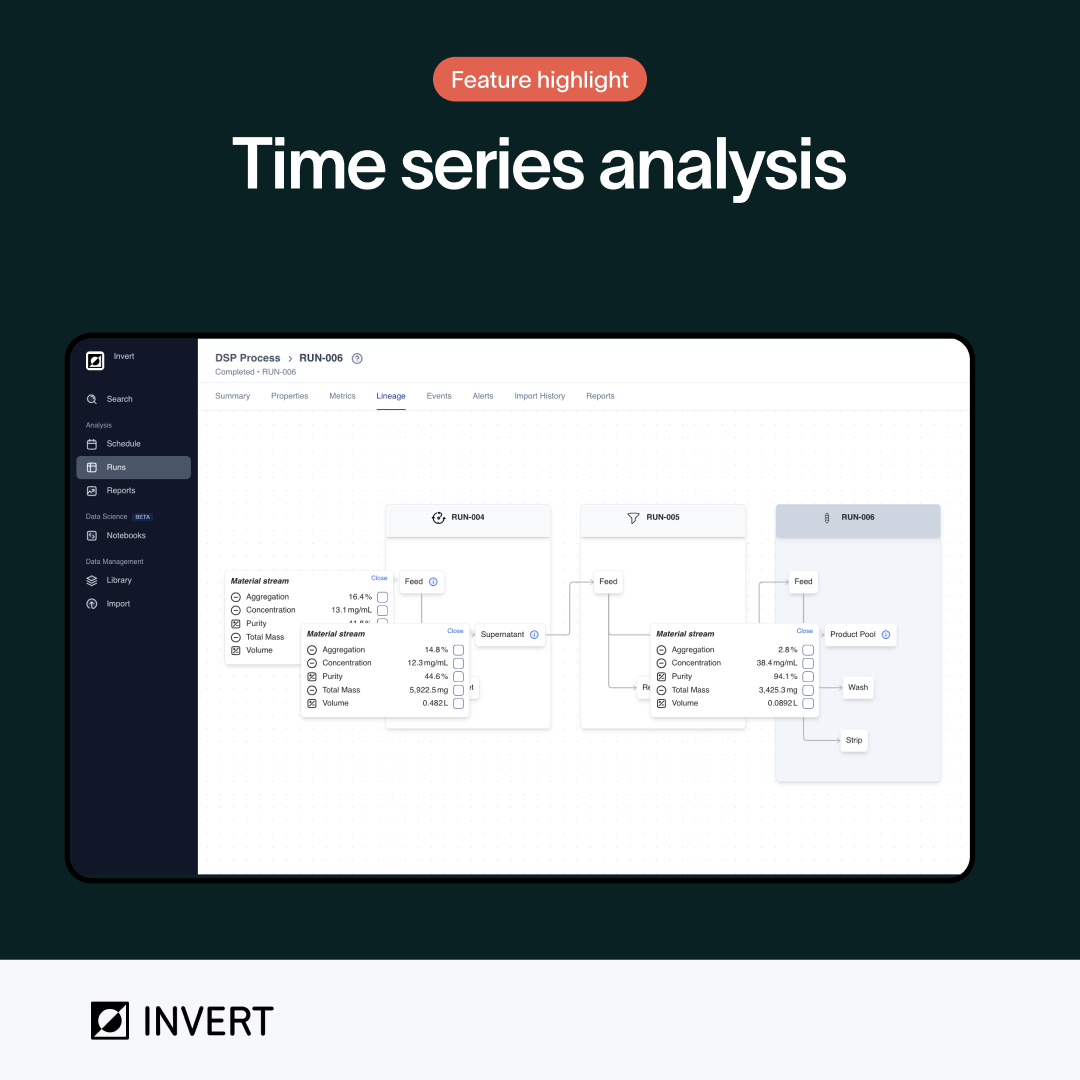Best Bioprocess Data Integration Platforms for Pharmaceutical Manufacturing Teams in 2025

TL;DR:
Pharmaceutical manufacturers face critical data integration challenges as bioprocess operations generate unprecedented volumes of fragmented information. Leading platforms like Invert, Qubicon, and Körber Pharma's PAS-X Savvy now offer AI-powered data unification, real-time monitoring, and regulatory compliance capabilities that reduce manual work by 90% while improving batch success rates by 25%.
Bioprocess Data Integration Platform Comparison
PlatformAI/ML CapabilitiesReal-Time MonitoringData ReductionBest ForInvertAdvanced predictive analyticsYes, AI-powered90% time reductionCDMO tech transferQubiconSoft sensors & KPIsReal-time comparison~75% manual effortProcess optimizationVimachemAI/IIoT analyticsYes, MES integratedPaperless operationsManufacturing executionSartorius (SIMCA)Multivariate analysisStatistical SPCPattern discoveryData science teamsArk BiotechIn silico simulationVirtual bioreactorEliminates test runsScale-up decisions
Why Bioprocess Data Integration is Critical in 2025
Pharmaceutical manufacturers confront a data paradox: while bioprocess operations generate massive volumes of data globally each day, much of it remains siloed, fragmented, and underutilized. The industry faces persistent challenges with data quality, with a significant share of FDA warning letters in recent years citing data accuracy issues. Organizations without modern data integration face regulatory risk, operational inefficiency, and delayed decision-making that impacts time-to-market for critical therapeutics.
The business case for modern bioprocess data integration platforms has never been stronger. Digital maturity has improved meaningfully over the past several years, yet many biopharmaceutical organizations still operate hybrid systems that combine digital and paper-based records. This transitional state creates operational complexity without delivering expected efficiency gains—particularly in technology transfer scenarios where CDMO partnerships require seamless data exchange.
1. Invert - Real-Time Bioprocess AI Software
Invert delivers purpose-built bioprocess AI software that transforms fragmented upstream and downstream data into real-time insights and AI-driven decisions. The platform unifies and harmonizes time-series data across instruments, manufacturing sites, and external CDMOs, establishing an AI-ready data foundation from day one. Invert’s intelligence layer provides transparent AI chat capabilities enabling scientists to ask complex questions about bioprocess data and receive instant, verifiable answers without writing code.
Manufacturing teams implementing Invert have achieved measurable operational benefits: dramatic reductions in manual data cleanup time, cost savings through avoided wasted runs, and fewer batch failures through early detection and live visibility. The platform executes bioprocess analysis that typically requires expert teams hours to complete manually—condensing months of traditional work into seconds through AI assistance.
2. Qubicon - Advanced Bioprocess Data Platform
Qubicon centralizes bioprocess data from online, at-line, and offline equipment into a unified database with real-time comparison capabilities and intelligent alerting. The platform compares live quality data against reference runs, calculates key performance indicators in real-time, and applies custom soft sensor models for advanced process monitoring. Client-server architecture with broad access supports collaboration across development and manufacturing teams.
3. Vimachem - AI-Driven Pharma MES Platform
Vimachem provides a modular, composable Pharma 4.0 MES accelerating digital transformation through integrated machine connectivity, manufacturing analytics, and electronic batch records. The bioprocess monitoring layer uses AI and IIoT to track OEE and machine performance while ensuring compliance with electronic record standards and enabling paperless operations.
4. Sartorius Data Analytics Suite - DOE and Real-Time Monitoring
Sartorius combines Design of Experiments, multivariate data analysis, and real-time monitoring via MODDE and SIMCA. These tools support Quality by Design approaches, accelerate process development with efficient experimentation, and provide SPC/MPC methods for continuous manufacturing and batch optimization.
5. LabKey Server - Scientific Data Management System
LabKey Server is a customizable scientific data management system covering sample/LIMS workflows, ELN, and specialized biologics tools. It supports complex bioprocess and clinical data with audit trails and role-based security, helping large teams manage multi-study, multi-site programs.
6. Ark Biotech - Virtual Bioreactor Simulation Software
Ark Biotech offers high-fidelity in silico simulation to design, optimize, and scale cell culture processes through advanced multiphysics modeling. A no-code interface visualizes numerous time-series metrics and soft sensors, enabling rapid exploration of process variants and reducing the need for physical experimentation.
7. ModelFlow (PolyModels Hub) - Digital Backbone for Pharma Process Development
ModelFlow integrates models, scientific data, and insights into a cohesive platform for process development across modalities. Teams gain tailored modeling recommendations and streamlined workflows that reduce decision time and build reusable knowledge for future products.
8. Körber Pharma PAS-X Savvy - Integrated Bioprocess Analytics
PAS-X Savvy unites data management and analytics for development, scale-up, validation, and manufacturing excellence. It tackles data accessibility and structure challenges with comprehensive visualization, statistical evaluation, soft sensor support, and tools for scale correlation and Quality-by-Design.
Critical Data Integration Features for Manufacturing Success
When evaluating platforms, prioritize FAIR-aligned data foundations (findable, accessible, interoperable, reusable), robust integration with CPP/CQA monitoring, and automated audit trails supporting 21 CFR Part 11. Real-time harmonization across vendors and sites enables unified decision-making and breaks legacy silos. Establish clear data governance (ownership, quality standards, access controls), invest in workforce upskilling, and secure executive sponsorship to overcome adoption barriers and realize substantial timeline reductions.
Frequently Asked Questions
What is the primary difference between data integration platforms and traditional LIMS systems?
Data integration platforms consolidate information from bioreactors, analytical instruments, MES, and EBR systems into unified environments with real-time analytics and AI. Traditional LIMS primarily manage sample tracking and testing workflows without deep bioreactor integration or advanced analytics.
How do these platforms address 21 CFR Part 11 compliance requirements?
Leading platforms include audit trails, access controls, e-signatures, and data integrity protections; they maintain activity logs and support role-based permissions to safeguard sensitive manufacturing data.
Can these platforms integrate with existing CDMO partnerships?
Yes. Modern platforms support secure data sharing via portals, standardized formats, and granular access controls—enabling contextualized data exchange, streamlined tech transfer, and full traceability.
What implementation timeline should we expect?
Timelines vary by complexity and scope. Focused implementations can land core functionality in months; enterprise rollouts generally progress in phases—pilot first, then scale.
How significant are the cost savings?
Organizations report large reductions in manual data prep, fewer wasted runs, faster release, and lower batch failure rates—driving strong ROI within typical enterprise investment horizons.
Conclusion & Next Steps
Biopharma manufacturers must accelerate timelines, enhance efficiency, and uphold compliance amid rising complexity. Modern data integration platforms turn fragmented data into decisions—automating manual work while improving batch outcomes. Evaluate options based on monitoring, analytics sophistication, compliance features, and integration flexibility. The advantage goes to teams who move now.
References
Invert – Invert Assist Launch (Press Release)
Ark Biotech – Technology Overview
PolyModels Hub – Seed Round Announcement
BioProcess International – FDA Prelicense Inspections
BioPharm International – Digital Transformation in Biopharma
Scientific Bio – Quality by Design
FDA – AI to Support Regulatory Decision-Making
Deloitte – 2025 Life Sciences Executive Outlook
BioProcess International – Essentials in QbD
Sartorius – SIMCA (MVDA Software)
Bruehlmann Consulting – Future of Bioprocessing
Sigma-Aldrich – Process Analytical Technology
Sartorius – MVDA Software Overview
Bioprocessing Summit – Digital Transformation
Thermo Fisher – Process Analytical Technology
Körber Pharma – What Is a Soft Sensor?
RAPS – FDA Finds Data Integrity Problems
Virto – Pharma Digital Transformation
BioProcess Online – Real-Time Cell Density via Soft Sensors
BioProcess International – Reimagining Digitalization (Article 1)
BioProcess International – Soft Sensors for Bioprocess Monitoring
BioProcess Online – Continuous Manufacturing: Why Few Have It
PubMed Central – Article: PMC11718427
BioProcess International – Reimagining Digitalization (Article 2)
PubMed Central – Article: PMC11994081
Vimachem – Bioprocess Monitoring Software
BioProcess International – Process Excellence
Körber – Digital Maturity Assessment
Vimachem – Electronic Batch Records
BioProcess International – Hitchhiker’s Guide to Bioprocess Design
Deloitte – Digital Maturity Index
BioProcess International – Data Overabundance in Biomanufacturing
FDA – Part 11: Electronic Records/Electronic Signatures
Tecnic – Trends in Bioprocessing for 2025
BioPharm International – PDA 2025: Data Governance & AI
BioProcess International – 21 CFR Part 11 Revisited
Bioprocessing Summit – Digital Transformation (Alt Link)
INFORS HT – 6 Bioprocess Software Must-Haves
Invert – Bioprocess Tech Transfer: The Data Dilemma
BioProcess International – Digital Platform for Data Science
BioProcess International – June 2025 Issue
Körber Pharma – Data Management for Successful Tech Transfer
IDBS – Importance of AI in Process Development
BioProcess International – Beyond Compliance for CGT
BioPhorum – Technology Strategy: Delivering ROI
BioProcess International – AI in Quality Management Systems

Connecting Shake Flask to Final Product with Lineage Views in Invert
Invert’s lineage view connects products across every unit operation and material transfer throughout the entire process. It acts as a family tree for your product, tracing its origins back through purification, fermentation, and inoculation. Instead of manually tracking down the source of each data point, lineages automatically show material streams as they pass through each step.
Read More ↗
Engineer Blog Series: Security & Compliance with Tiffany Huang
Welcome to Invert's Engineering Blog Series, a behind-the-scenes look into the product and how it's built. For our third post, senior software engineer Tiffany Huang speaks about how trust and security is a foundational principle at Invert, and how we ensure that data is kept secure, private, and compliant with industry regulations.
Read More ↗
Analyzing Real-Time Time Series Data in Bioprocess with Invert
In modern biomanufacturing, success hinges on the ability to make informed decisions fast. The ability to analyze data directly impacts productivity, product quality, and ultimately, time to market, whether you're optimizing a fed-batch fermentation, troubleshooting a chromatography run, or validating a filtration process. However, its massive volume, high dimensionality, and low latency of time series data in bioprocess means that most software are not built to effectively capture, let alone analyze it.
Read More ↗